January 4, 2017 feature
Multiple copies of the Standard Model could solve the hierarchy problem

(Phys.org)—One of the unanswered questions in particle physics is the hierarchy problem, which has implications for understanding why some of the fundamental forces are so much stronger than others. The strengths of the forces are determined by the masses of their corresponding force-carrying particles (bosons), and these masses in turn are determined by the Higgs field, as measured by the Higgs vacuum expectation value.
So the hierarchy problem is often stated as a problem with the Higgs field: specifically, why is the Higgs vacuum expectation value so much smaller than the largest energy scales in the universe, in particular the scale at which gravity (by far the weakest of the forces) becomes strong? Reconciling this apparent discrepancy would impact physicists' understanding of particle physics at the most fundamental level.
"The hierarchy problem is one of the deepest questions in particle physics, and almost every one of its known solutions corresponds to a different vision of the universe," Raffaele Tito D'Agnolo, a physicist at Princeton, told Phys.org. "Identifying the correct answer will not just solve a conceptual puzzle, but will change the way we think about particle physics."
In a new paper published in Physical Review Letters, D'Agnolo and his coauthors have proposed a solution to the hierarchy problem that involves multiple (up to 1016) copies of the Standard Model, each with a different Higgs vacuum expectation value. In this model, the universe consists of many sectors, each of which is governed by its own version of the Standard Model with its own Higgs vacuum expectation value. Our sector is the one with the smallest nonzero value.
If, in the very early universe, all sectors had comparable temperatures and seemingly equal chances of dominating, why did our sector, with the smallest nonzero Higgs vacuum expectation value, come to dominate? The physicists introduce a new mechanism called a "reheaton field" that explains this by reheating the universe as it decays. The physicists show that there are several ways in which the reheaton field could have preferentially decayed into and deposited the majority of its energy into the sector with the smallest Higgs vacuum expectation value, causing this sector to eventually dominate and become our observable universe.
Compared to other proposed solutions to the hierarchy problem, such as supersymmetry and extra dimensions, the new proposal—which the physicists call "N-naturalness"—is different in that the solution does not rely solely on new particles. Although the new proposal shares some features with both supersymmetry and extra dimensions, one of its unique characteristics is that it is not only new particles, but more importantly cosmological dynamics, that is central to the solution.
"N-naturalness is qualitatively different from the solutions to the hierarchy problem proposed in the past, and it predicts signals in cosmic microwave background (CMB) experiments and large-scale structure surveys, two probes of nature that were thought to be unrelated to the problem," D'Agnolo said.
As the physicists explain, it should be possible to detect signatures of N-naturalness by searching for signs of the existence of other sectors. For instance, future CMB experiments might detect extra radiation and changes in neutrino cosmology, since neutrinos in nearby sectors are expected to be slightly heavier and less abundant than those in our sector. This approach is interesting for another reason: the neutrinos in the other sectors are also a viable dark matter candidate, which the researchers plan to study in more detail. Future experiments might also find signatures of N-naturalness in the form of a larger-than-expected mass of axion particles, as well as supersymmetric signatures due to possible connections to supersymmetry.
"If new relativistic species are not detected by the next generation of CMB experiments (Stage 4), then I will stop thinking of N-naturalness as a possible solution to the hierarchy problem," D'Agnolo said. "According to the current timeline, these experiments should start taking data around 2020 and reach their physics goals in approximately five years."
More information: Nima Arkani-Hamed et al. "Solving the Hierarchy Problem at Reheating with a Large Number of Degrees of Freedom." Physical Review Letters. DOI: 10.1103/PhysRevLett.117.251801. Also at arXiv:1607.06821 [hep-ph]
Journal information: Physical Review Letters
© 2017 Phys.org



















